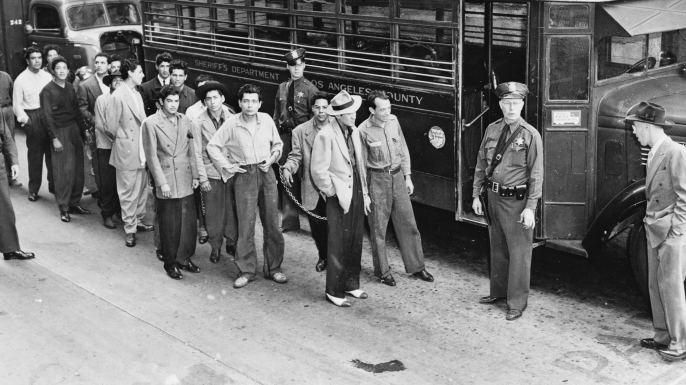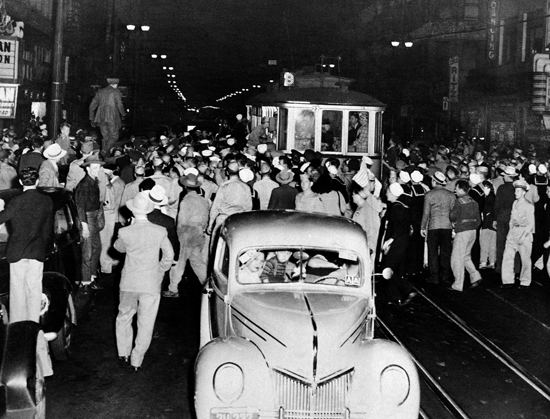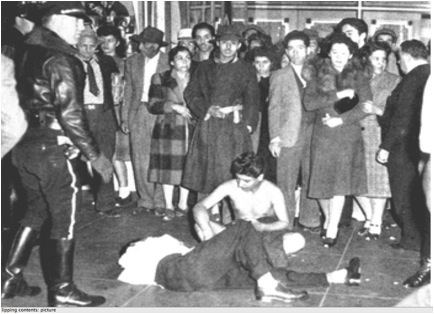Methods Widespread rioting | Date June 1943 | |
 | ||
Causes Conflict between American servicemen stationed in Southern California and Mexican-American youths | ||
The Zoot Suit Riots were a series of attacks in June 1943 in Los Angeles, California, United States, by white American servicemen stationed in Southern California against Mexican American youths and other minorities who were residents of the city.
Contents
- Zoot suit riots causes and riots
- Origins
- Immediate lead up to the riots
- The riots
- Reactions
- In popular culture
- References

White servicemen and civilians attacked and stripped youths who wore zoot suits ostensibly because they considered the outfits to be unpatriotic during wartime, as they had a lot of fabric. Rationing of fabric was required for the World War II war effort. While most of the violence was directed toward Mexican American youth, the whites also attacked young African American and Filipino Americans who were wearing zoot suits.

The Zoot Suit Riots were related to fears and hostilities aroused by the coverage of the Sleepy Lagoon murder trial, following the killing of a young Latino man in a barrio near Los Angeles. The riot appeared to trigger similar attacks that year by whites against Latinos in Chicago, San Diego, Oakland, Evansville, Philadelphia, and New York City.

Zoot suit riots causes and riots
Origins

During the early 20th century, many Mexicans immigrated for work to such areas as Texas, Arizona, and California. They were recruited by farmers for work on the large farms, and also worked throughout those states in non-agricultural jobs.
During the Great Depression, in the early 1930s, the United States deported between 500,000 and 2 million people of Mexican descent (including the illegal expulsion of up to 1.2 million U.S. citizens) to Mexico (see Mexican Repatriation), in order to reduce demands on limited American economic resources. By the late 1930s about 3 million Mexican Americans resided in the United States. Los Angeles had the highest concentration of ethnic Mexicans outside Mexico.
As residents of California prior to European settlement, many Latinos occupied historic areas. More recent Mexican immigrants joined them in those areas, and the minority had long been informally segregated and restricted to an area of the city with the oldest, most run-down housing. Job discrimination in Los Angeles forced many Mexicans to work for below-poverty level wages. The Los Angeles newspapers described Mexicans with racially inflammatory propaganda, suggesting a problem with juvenile delinquency. These factors caused much racial tension between Mexicans and whites.
During the late 1930s, young Latinos in California, for whom the media usually used the then-derogatory term Chicanos, created a youth culture. Long considered a disparaging term in Mexico, the term "Chicano" gradually was transformed from a class-based term of derision to one of ethnic pride and general usage within Mexican-American communities beginning with the rise of the Chicano movement in the 1960s.
Lalo Guerrero became known as the father of Chicano music, as the young people adopted a music, language and dress of their own. Young men wore zoot suits—a flamboyant long jacket with baggy pegged pants, sometimes accessorized with a pork pie hat, a long watch chain, and shoes with thick soles. They called themselves "pachucos." In the early 1940s, arrests of Mexican-American youths and negative stories in the Los Angeles Times fueled a perception that these pachuco gangs were delinquents who were a threat to the broader community.
In the summer of 1942, the Sleepy Lagoon murder case made national news. Nine teenage members of the 38th Street Gang were accused of murdering a civilian man named José Díaz in an abandoned quarry pit. The nine defendants were convicted at trial and sentenced to long prison terms. Eduardo Obregón Pagán wrote,
"Many Angelenos saw the death of José Díaz as a tragedy that resulted from a larger pattern of lawlessness and rebellion among Mexican American youths, discerned through their self-conscious fashioning of difference, and increasingly called for stronger measures to crack down on juvenile delinquency."
The convictions of the nine young men were ultimately overturned, but the case generated much animosity within the white community toward Mexican Americans. The police and press characterized all Mexican youths as "pachuco hoodlums and baby gangsters."
With the entry of the United States into World War II in December 1941 following the Japanese attack on Pearl Harbor, the nation had to deal with the restrictions of rationing and the prospects of conscription. In March 1942, the War Production Board (WPB) regulated the manufacture of men's suits and all clothing that contained wool. To achieve a 26% cut-back in the use of fabrics, the WPB issued regulations for the manufacture of what Esquire magazine called, "streamlined suits by Uncle Sam." The regulations effectively forbade the manufacture of the wide-cut zoot suits and full women's skirts or dresses. Most legitimate tailoring companies ceased to manufacture or advertise any suits that fell outside the War Production Board's guidelines. But the demand for zoot suits did not decline; a network of bootleg tailors based in Los Angeles and New York City continued to produce the garments. Youths also continued to wear clothes which they already owned.
Meanwhile, thousands of American soldiers, sailors, and Marines from across the country arrived in Los Angeles as part of the war effort; they were given leave while awaiting to be shipped out to the Pacific Front. Servicemen and zoot suiters in Los Angeles were both immediately identifiable by their dress. Some whites thought that the continued wearing of zoot suits represented the youths' public flouting of rationing regulations. White officials began to cast wearing of zoot suits in moral terms, and associated it with the commission of petty crime, violence and the snubbing of national wartime rules. By the end of the war, Mexican-American men were over-represented in the United States Armed Forces as a percentage of their population and they had the highest percentage of Congressional Medal of Honor winners. Whites did not know those facts. In 1943, many white American servicemen resented the sight of young Latinos wearing zoot suits after clothing restrictions had been published, especially as most came from areas of the country with little experience or knowledge of Mexican-American culture.
Immediate lead-up to the riots
Following the Sleepy Lagoon case, U.S. service personnel got into violent altercations with young Mexican Americans in zoot suits in San Jose, Oakland, San Diego, Delano, Los Angeles, and lesser cities and towns in California. During this period, the immense war buildup attracted tens of thousands of new workers to major installations, including many African Americans in the second wave of the Great Migration.
The most serious ethnic conflicts erupted in Los Angeles. Two altercations between military personnel and zoot suiters catalyzed the larger riots. The first occurred on May 30, 1943, four days before the start of the riots. A dozen sailors, including Seaman Second Class Joe Dacy Coleman, were walking down Main Street in Los Angeles when they spotted a group of women on the opposite side. The group, except for Coleman, crossed the street to speak to the women. Coleman continued, walking past two zoot suiters; one of them raised his arm, and the sailor turned and grabbed it. A fight broke out during which the sailor was struck in the back of the head, falling unconscious to the ground, breaking his jaw in two places. On the opposite side of the street, five young men attacked the group of servicemen for trying to talk to the Latino women. The other servicemen fought their way back to Coleman and dragged him to safety.
Four nights later on June 3, 1943, another incident erupted. About eleven sailors got off a bus and started walking along Main Street in Downtown Los Angeles. Encountering a group of young Mexicans in zoot suits, they got into a verbal argument. The sailors later told police authorities that they were jumped and beaten by this gang. The Los Angeles Police Department (LAPD) responded to the incident, including many off-duty officers who identified as the Vengeance Squad. The officers went to the scene "seeking to clean up Main Street from what they viewed as the loathsome influence of pachuco gangs."
The next day, 200 sailors got a convoy of about 20 taxicabs and headed for East Los Angeles, the center of Mexican-American settlement. The sailors spotted a group of young zoot suiters and assaulted them with clubs. They stripped the boys of the zoot suits and burned the tattered clothes in a pile. They attacked and stripped everyone they came across who were wearing zoot suits. The Zoot Suit Riots spread.
The riots
As the violence escalated over the ensuing days, thousands of white servicemen and civilians joined the attacks, marching abreast down streets, entering bars and movie houses, and assaulting any young Latino males they encountered. In one incident, sailors dragged two zoot suiters on-stage as a film was being screened, stripped them in front of the audience, and then urinated on their suits. Although police personnel (mostly white) accompanied the rioting servicemen and civilians, they had orders not to arrest any, and some of them joined in the rioting. After several days, more than 150 people had been injured, and the police had arrested more than 500 Latino civilians on charges ranging from "rioting" to "vagrancy".
A witness to the attacks, journalist Carey McWilliams wrote,
Marching through the streets of downtown Los Angeles, a mob of several thousand soldiers, sailors, and civilians, proceeded to beat up every zoot suiter they could find. Pushing its way into the important motion picture theaters, the mob ordered the management to turn on the house lights and then ran up and down the aisles dragging Mexicans out of their seats. Streetcars were halted while Mexicans, and some Filipinos and Negroes, were jerked from their seats, pushed into the streets and beaten with a sadistic frenzy.
The local white press lauded the racial attacks, describing them as having a "cleansing effect" to rid Los Angeles of "miscreants" and "hoodlums". As the riots progressed, the media reported the arrest of Amelia Venegas, a female zoot suiter charged with carrying a brass knuckleduster. While the revelation of female pachucos' (pachucas) involvement in the riots led to frequent coverage of the activities of female pachuca gangs, the media suppressed any mention of the white American pachuco gangs that were also involved.
The Los Angeles City Council approved a resolution criminalizing the wearing of "zoot suits with reat [sic] pleats within the city limits of LA." Councilman Norris Nelson had stated, "The zoot suit has become a badge of hoodlumism." No ordinance was approved by the City Council or signed into law by the Mayor, but the council encouraged the WPB to take steps "to curb illegal production of men's clothing in violation of WPB limitation orders." While the servicemen and civilians had first targeted only pachucos, they also attacked African Americans in zoot suits who lived in the Central Avenue corridor area. The Navy and Marine Corps command staffs intervened on June 7 to reduce the attacks, confining sailors and Marines to barracks and ordering that Los Angeles be declared off limits to all military personnel; this was enforced by Navy Shore Patrol personnel. Their official position was that their men were acting in self defense.
By the middle of June, the riots in Los Angeles were declining, but white riots against Latinos erupted in other cities in California, as well as in cities in Texas and Arizona. Related incidents broke out in northern cities such as Detroit, New York City, and Philadelphia. In the latter city, two members of Gene Krupa's dance band were beaten up for wearing zoot suit stage costumes. A zoot suit riot at Cooley High School in Detroit, Michigan was initially dismissed as an "adolescent imitation" of the Los Angeles riots. But, within weeks, the worst race riot in Detroit's history had broken out, in which whites attacked African Americans and destroyed much of their neighborhood.
Reactions
As the riots subsided, nation-wide public condemnation of the military, police, and civilian officials followed. The most urgent concern of officials, however, was relations with Mexico, as the economy of Southern California relied on the importation of Mexican labor to assist in harvesting of California crops. After the Mexican Embassy lodged a formal protest with the State Department, Governor Earl Warren of California ordered the creation of the McGucken committee to investigate and determine the cause of the riots. In 1943, the committee issued its report; it determined racism to be a central cause of the riots, further stating that it was "an aggravating practice (of the media) to link the phrase zoot suit with the report of a crime." The governor appointed the Peace Officers Committee on Civil Disturbances, chaired by Robert W. Kenny, president of the National Lawyers Guild to make recommendations to the police. Human relations committees were appointed, and police departments were required to train their officers to treat all citizens equally.
At the same time, Mayor Fletcher Bowron came to his own conclusion. The riots, he said, were caused by Mexican juvenile delinquents and by white Southerners. The latter came from a region in which both overt legal and socially sanctioned white racial discrimination held sway. Racial prejudice in Los Angeles, according to Mayor Bowron, was not a factor.
A week later, First Lady Eleanor Roosevelt commented on the riots in her newspaper column. "The question goes deeper than just suits. It is a racial protest. I have been worried for a long time about the Mexican racial situation. It is a problem with roots going a long way back, and we do not always face these problems as we should." – June 16, 1943
The Los Angeles Times published an editorial the next day expressing outrage: it accused Mrs. Roosevelt of having communist leanings and stirring "race discord".
On June 21, 1943, the State Un-American Activities Committee, under state senator Jack Tenney, arrived in Los Angeles with orders to "determine whether the present Zoot Suit Riots were sponsored by Nazi agencies attempting to spread disunity between the United States and Latin-American countries." Although Tenney claimed he had evidence the riots were "[A]xis-sponsored", no evidence was ever presented to support this claim. Japanese propaganda broadcasts accused the United States' government of ignoring the brutality of U.S. Marines toward Mexicans. In late 1944, ignoring the findings of the McGucken committee and the unanimous reversal of the convictions by the appeals court in the Sleepy Lagoon case on October 4, the Tenney Committee announced that the National Lawyers Guild was an "effective communist front."
Many post-war civil rights activists and authors, such as Luis Valdez, Ralph Ellison, and Richard Wright, have said they were inspired by the Zoot Suit Riots. Cesar Chávez and Malcolm X were both zoot suiters as young men and later became political activists.
